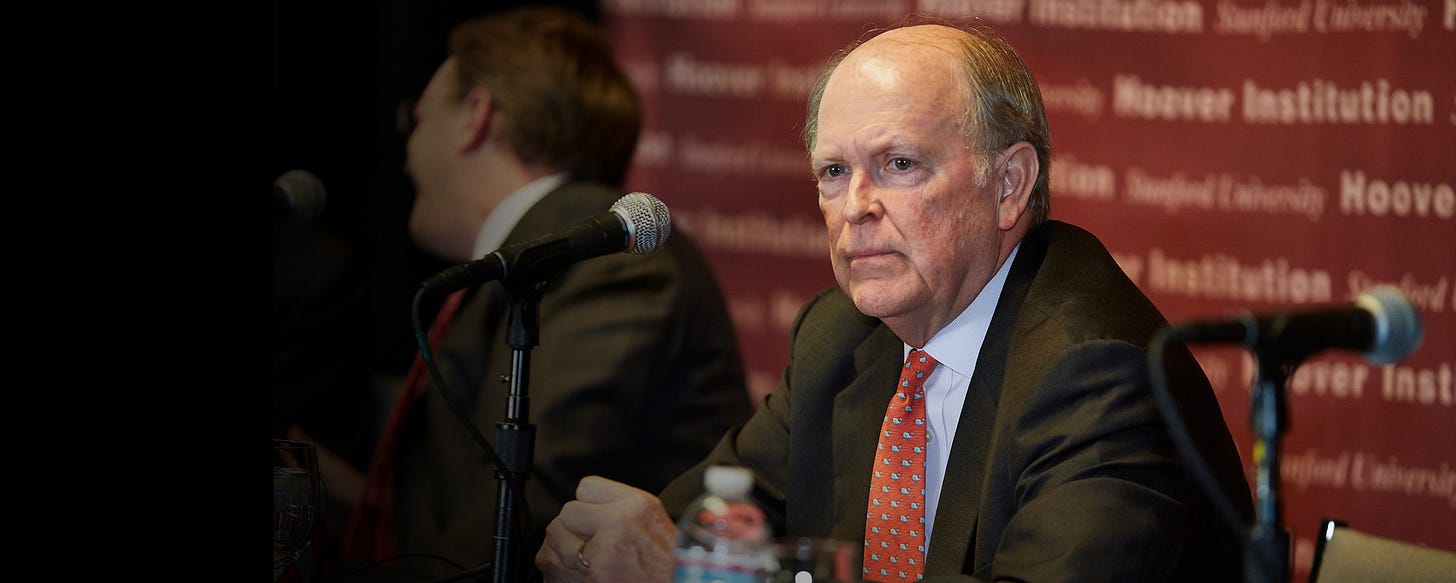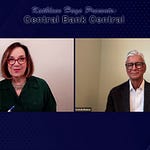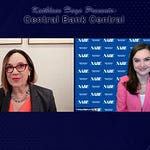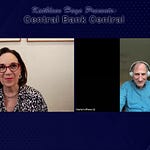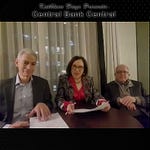Charles Plosser is uniquely qualified to kick off the Shadow Open Market Committee’s conference this week as it addressed one of the burning questions of 2025: “How Can the Fed Improve Its Policy Framework?” Bottom line: the Federal Reserve let inflation get out of control during the pandemic what must it do now to make sure it does not repeat the mistakes it just made?
For starters, Charlie was president of the Federal Reserve Bank of Philadelphia from 2006 to 2015 which means he a member of the Policymaking FOMC - Federal Open Market Committee - during the period of the Great Financial Crisis and beyond.
Prior to joining the Federal Reserve, Mr. Plosser was a faculty member for nearly 30 years at the University of Rochester's William E. Simon Graduate School of Business, where he held positions such as the John M. Olin Distinguished Professor of Economics and Public Policy, director of the Bradley Policy Research Center, and served as dean from 1993 to 2003. He was co-editor of the prestigious Journal of Monetary Economics for over 20-years. Clearly Charlie knows the theory behind monetary policy well.
To top all of this off, Charlie along with former St. Louis Fed president Jim Bullard were appointed by then Fed Chair Ben Bernanke to drive the landmark 2012 Framework Review where the Fed’s two percent inflation target was officially introduced.
As for what the Fed needs to do now as it sets it course for the next five years, Charlie says it must have balance and objectivity, not pre-suppose what the risks will be. A five-year framework must be flexible enough to stand the test of time.
Charlie teamed up with Mickey Levy, another well-known and longtime member of the SOMC, and fellow panelist at the conference, to co-write another paper on the issues facing the Fed now: “Restoring Symmetry and Simplicity in the Fed’s Strategic Framework.” Well worth the read.
https://shadowfed.org/wp-content/uploads/2025/04/SOMC-April-7-2025-Presentation-Levy-Plosser.pdf
This is the link to Charlie’s opening remarks where he gives a succinct overview of the 2012 framework review, again important to understand as a critical look at the 2020 review and what is needed in this year’s review.
https://shadowfed.org/wp-content/uploads/2025/04/SOMC4-25_Plosser_welcome.pdf
Another important note regarding the Conference regarding Jim Bullard who is now Dr. Samuel R. Allen Dean of the Mitch Daniels School of Business at Purdue University, which hosted the event. Jim presided over the entire day, welcoming participants, and leading a critical Q&A session with speakers, starting with former Fed Vice Chair Richard Clarida who was a key leader of the 2020 Framework Review.
Dive in and hear, see what Charlie says. Read it too. He’s clear, smart and understandable, as any good policymaker and professor must be.
In the beginning…the 2012 framework 00:01:14:18
Well, in 2012, when the first policy framework was announced, the big thing for the Fed was to express the view that it was committed to deliver and it was important to the Fed because its actions and ability to achieve that inflation very much involved setting expectations and signaling a commitment. That's what they tried to do. And that was a very important step for the Fed, something they had never done before, and that was in place through most of the decade following that.
The 2012 framework in action 00:02:03:08
But the decade after the financial crisis was unusual in many respects, very many challenges for the Fed, very many problems with banks and the fluidity of financial stability. But also during that period, the Fed made a policy that ultimately delivered an inflation rate that was somewhat below the 2% target, even in the face of unemployment falling very rapidly during the decade.
A less than perfect performance leads to a tweak 00:02:34:03
So everything didn't work out perfectly. But I think May 2020, what happened is the Fed saw that decade and said, well, it didn't go as we expected it looks like inflation's much harder, get up above 2% that we thought it would be, and as a result they took the opportunity, not unwisely so, to say, okay, what should we do different Should we tweak the 2012 statement or not?.
The undershooting was not such a big deal 00:03:45:15
<Small downside misses…>It shouldn't have <been a big deal>. Yeah, it was allowed <inflation> was lower that I think the Fed stated it to be given its policy of running zero interest rates for ten years or whatever. I think the Fed was surprised that it wasn't higher than that and that was the question they were struggling with. It's what they have to do. And why is that the case?
Switches gears to protect against too low inflation 00:04:36:17
And I think that's what fed into the review that the Fed chose to do in 2020. How do I get inflation up? Is it permanently down? Is something changed? And so that what happened was at that point, was it did the review and came to the conclusion, maybe indirectly, they came to conclusion, that their biggest task was not to worry about inflation, was to worry about too low inflation.
The Fed’s asymmetry and the pandemic spelled trouble 00:06:22:21
Well, I think a couple of things happened. One was the pandemic and obviously the size- magnitude - of the fiscal stimulus that went into that. But the Fed's new strategy was, was that they put the strategy in place to generate more inflation intentions. So, they had an asymmetric loss-function. They declared that, well, we know how to handle high inflation, we know how to handle low inflation… We have a asymmetric situation; they said they were more afraid of inflation being too low and being too high. So they adopted a framework that favored doing more stimulus. Well, they did that exactly the wrong time. They were looking to the past, as you said, and not looking forward to other things.
What this statement fixed was no long what was wrong 00:07:21:02
And they put too much weight on that. Recent past, designed a policy which was much more accommodating, much more willing to accommodate fiscal deficits and low inflation. And lo and behold, that's where we are. And so the policy was not well designed for what we faced after the pandemic. That's what got us in trouble. And so, I think that the end of the day, this new review that you find happening is… all right, how do we fix that?
Plosser’s objective for a fix 00:08:16:20
Well, the number one thing is to have a strategy that is symmetric and balanced. It was 2012 strategy. If we were below inflation, we tried to get it up. If we were above inflation target, we tried to get it down. It was pretty easy. Pretty well, not easy to do, but to identify. That's not what we have now. And so, we need to go back to a more balanced approach. That's the first thing we need to do.
Policy should not be phenomenon dependent 00:08:55:11
The same thing we need to do is to look for a strategy that's less dependent on a particular phenomena or particular model and realize that we need - the Fed needs - to be robust, a framework needs to be robust to handle all sorts of shock and surprises, whether it be wars in Ukraine, a trade policy from that president. The Fed needs to be disciplined, but they need a more balanced and robust approach.
The ability to be preemptive is important- 00:09:43:04
Well, in principle, the Fed has to be able to be preemptive because prices are sticky. Monetary policy has long lags. Right. And so they need to be thinking about being preemptive. By not being preemptive, they at when they get
behind the curve. So, yes, preemption ought to be part of the framework of liability. You shouldn't rule it out
Inflation pain and unemployment-inflation trade-offs 00:10:32:00
Well, there other some tradeoff involved here, and that's always the case. But I think the important thing here is that the public mood swings. Right now, after what happened in ‘21 and ‘22 and later in ‘2020, inflation, they hate inflation. Inflation's very disruptive. Yes. And very costly to the working person. And sometimes the people in lower jobs, lower paying jobs who are harmed most by inflation. So, the public's sensitivity to inflation versus employment can vary over time, I think is important that the Fed try to try to have a stable approach to that and not be whip-sawed from one objective to another. Objective. And I try to try to make it objective, stable and consistent so it doesn't get that virtual fact at 50 for inflation, inflation fighting unemployment fighting.
What the Fed should do now…00:12:46:20
I would say that if I was at the Fed now, I think the Fed needs to sort of stand pat for a while. They don't know what's going to happen. They don't know what policies are going to come from the White House. They don't know what you have for trade, and they don't know what's going to happen to the economy. I think it's very wise not to try to predetermine a project that that they need to be prepared that one way or another. But I would not be -I would not think - the Fed should be out in front of this because there's just too much uncertainty. I could go either way.
Fellow
Charles I. Plosser
Plosser served as the President and CEO of the Federal Reserve Bank of Philadelphia from 2006 until his retirement in 2015.
In his position he served as a member of the Federal Open Market Committee, which is responsible for U.S. monetary policy. During this period the world experienced a global financial crisis and a severe recession, requiring extraordinary action by monetary policymakers. He also served during a time of dramatic change in the activities of the Federal Reserve Banks including their role in financial services and the payments system as well as bank supervision. Among many other duties, he chaired the Committee on Investment Performance, which was responsible for oversight of the entire Federal Reserve System’s employee pension and thrift funds.
Prior to joining the Federal Reserve, Plosser was the John M. Olin Distinguished Professor of Economics and Public Policy and director of the Bradley Policy Research Center at the University of Rochester’s William E. Simon Graduate School of Business Administration where he served as Dean from 1993 to 2003. In 2004 he was a visiting scholar at the Bank of England. He is also a Research Associate at the National Bureau of Economic Research in Cambridge, Massachusetts. Over the years, Plosser has lectured to academic and business audiences worldwide on topics ranging from management education to economics and public policy issues. Prior to his public service at the Federal Reserve he also served as a consultant to numerous corporations on topics ranging from strategic planning and forecasting to portfolio and pension fund management, capital budgeting, and financial analysis. He was a member of the New York State Board of Economic Advisors and has served on the board of directors of ViaHealth, Inc. and RGS Energy Group, Inc. He has also served on the Advisory Board of the University Technology Seed Fund, LLC. In addition, he served as a director of the Graduate Management Admission Council from 1997 to 2003 and served as chairman of the board from 2002 to 2003.
Since January 2016, Plosser has served as a Public Governor for FINRA, the Financial Industry Regulatory Authority, where he serves on the Investment Committee and the Finance, Operations and Technology Committee.


